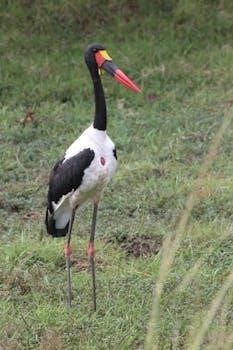
-
By:
- elizabeth
- No comment
it’s not the stork pdf
Its Not the Stork PDF⁚ A Comprehensive Guide
This guide explores “Its Not the Stork!” and its PDF availability. The book answers children’s questions about bodies, gender, and reproduction in an age-appropriate manner. It is a valuable resource for parents, educators, and caregivers seeking to comfortably discuss these topics. Its engaging artwork and clear language make it an accessible tool.
Overview of “Its Not the Stork!”
“Its Not the Stork!” is a book designed to address the complex questions young children have about their bodies, where babies come from, and the differences between girls and boys. Penned by Robie H. Harris and brought to life with Michael Emberley’s engaging illustrations, it offers a comfortable and reassuring approach to topics often considered sensitive or taboo. Unlike the old myth, the book provides accurate information about reproduction, birth, and family structures, acknowledging the diverse forms that families can take.
The book aims to foster curiosity and affirm children’s natural desire to understand their world. It covers a range of subjects, including gender differences, sexual reproduction, pregnancy, and birth, all presented in a way that is both informative and age-appropriate. “Its Not the Stork!” serves as a valuable resource for parents, educators, and caregivers, enabling them to have open and honest conversations with children about these important aspects of life. By using clear language and sensitive artwork, the book helps to create a safe and supportive environment for learning and exploration.
Furthermore, the book emphasizes the joys of love and the miracle of birth, celebrating the human body and the process of creating new life.
Target Audience and Age Appropriateness

“Its Not the Stork!” is primarily targeted towards preschool, kindergarten, and early elementary school children. The book’s content and presentation style are carefully tailored to suit the developmental stage and understanding of children in this age group. The authors use simple, clear language and avoid complex scientific terminology, ensuring that the information is easily accessible to young readers. The illustrations by Michael Emberley are engaging and child-friendly, helping to capture the attention of the target audience and make the learning experience more enjoyable.


The book is designed to answer the endless and perfectly normal questions that young children have about their bodies, families, and how babies are made. It addresses these topics in a reassuring and age-appropriate manner, mindful of a child’s healthy curiosity and need for accurate information. While the book covers sensitive subjects such as gender differences, sexuality, and reproduction, it does so with sensitivity and care, avoiding any content that may be considered too explicit or overwhelming for young children.
Parents and educators can use “Its Not the Stork!” as a tool to initiate conversations about these topics and provide children with a foundation of knowledge that they can build upon as they grow older.
Key Topics Covered in the Book
“Its Not the Stork!” delves into a range of essential topics related to human development and relationships. The book comprehensively covers sexual reproduction, providing young readers with a foundational understanding of how babies are conceived and born. It explores the joys of love in its many forms, emphasizing the importance of affection and connection within families and friendships. Pregnancy is another key area addressed, with explanations about the changes that occur in a woman’s body during this time and the development of the baby.
Furthermore, the book tackles the miracle of birth, offering a gentle introduction to the process of childbirth. It explains gender differences in a way that acknowledges children’s natural curiosity and affirms their need to understand these distinctions. “Its Not the Stork!” also discusses bodies, families, and friends, highlighting the diversity of family structures and the importance of healthy relationships. The book aims to answer children’s questions about these topics honestly and comfortably, using age-appropriate language and engaging illustrations.
By addressing these key topics, the book provides a valuable resource for parents and educators seeking to guide children through the complexities of growing up and understanding their bodies and relationships.
Addressing Questions About Gender and Sexuality
“Its Not the Stork!” directly and thoughtfully addresses the questions children often have about gender and sexuality. It acknowledges that children are naturally curious about the differences between boys and girls, and it provides clear, age-appropriate explanations to satisfy this curiosity. The book uses comfortable language and sensitive artwork to create a reassuring atmosphere for young readers. It affirms their need to be curious and provides a foundation for understanding gender identity and sexual orientation as they grow older.
The book aims to answer questions honestly without overwhelming children with too much information. It presents information in a way that is easy to understand and relatable, using bird and bee cartoon characters to illustrate key concepts. “Its Not the Stork!” helps parents and educators navigate these sensitive topics by providing a framework for open and honest conversations. It empowers children to ask questions and seek answers in a safe and supportive environment.
By addressing questions about gender and sexuality in a straightforward and accessible manner, the book helps to promote understanding, acceptance, and respect for diversity. It encourages children to embrace their own identities and to appreciate the differences among their peers.
Explaining Reproduction and Birth
“Its Not the Stork!” provides a clear and age-appropriate explanation of human reproduction and birth. The book addresses this complex topic with sensitivity and honesty, using language that young children can easily understand. Through engaging artwork and simple explanations, it demystifies the process of how babies are made and how they come into the world. It also covers the joys of love and the mysteries of pregnancy.
The book avoids overwhelming children with technical details, instead focusing on the essential concepts in a relatable way. The use of cartoon characters, such as birds and bees, helps to make the topic less intimidating and more approachable for young readers. “Its Not the Stork!” explains the roles of both parents in the creation of a baby, emphasizing the importance of love and care in the process.
By providing a factual and age-appropriate account of reproduction and birth, the book helps to alleviate children’s anxieties and misconceptions. It empowers them with knowledge and encourages them to ask questions, creating a foundation for healthy attitudes towards sexuality and family.
The Role of Families and Friends
“Its Not the Stork!” emphasizes the importance of families and friends in a child’s life, highlighting the diverse forms that families can take. The book promotes inclusivity and acceptance, showcasing different family structures beyond the traditional nuclear family. It acknowledges that families can be made up of various combinations of parents, siblings, grandparents, and other loved ones, all bound by love and support.
The book also explores the vital role that friends play in a child’s development and well-being. It encourages children to build strong and healthy relationships with their peers, emphasizing the importance of kindness, empathy, and respect. “Its Not the Stork!” underscores the idea that families and friends provide a sense of belonging, security, and unconditional love, which are essential for a child’s emotional growth.
By celebrating the diversity of families and the significance of friendships, the book promotes a sense of community and connection. It teaches children to appreciate the different forms of love and support that exist in their lives, fostering a more inclusive and compassionate worldview.
Illustrations and Artwork by Michael Emberley
Michael Emberley’s illustrations are integral to the success and appeal of “Its Not the Stork!” His artwork is described as sensitive, engaging, and comfortable, perfectly complementing Robie H. Harris’s reassuring language. Emberley uses lively and approachable characters to convey complex information about bodies, babies, and families in a way that is easy for young children to understand.
The illustrations are not only informative but also visually captivating, drawing children into the book and encouraging them to explore the topics being discussed. Emberley’s use of color, line, and composition creates a warm and inviting atmosphere, making potentially awkward or sensitive subjects feel more approachable and less intimidating. The artwork also reflects the book’s emphasis on diversity and inclusivity, showcasing a wide range of characters and family structures.
Furthermore, Emberley’s illustrations add a layer of humor and playfulness to the book, making it an enjoyable read for both children and adults. His artistic style is distinct and memorable, contributing significantly to the book’s overall educational value and lasting impact.
Critical Reception and Reviews
“Its Not the Stork!” has garnered significant critical acclaim for its honest and age-appropriate approach to discussing sensitive topics with young children. Reviews often highlight the book’s success in addressing questions about gender, sexuality, and reproduction in a comfortable and informative way. Critics praise Robie H. Harris’s accessible language and Michael Emberley’s engaging illustrations for making the book both educational and enjoyable.
Many reviewers emphasize the book’s value as a resource for parents, educators, and caregivers seeking to navigate these conversations with children. The book is often lauded for its ability to answer endless and perfectly normal questions that preschool, kindergarten, and early elementary school children ask about how they began. Some reviews also note the book’s inclusive approach, representing diverse families and experiences.
However, some critical discussions may also arise concerning the book’s specific content or approach. Despite this, “Its Not the Stork!” generally receives positive feedback for its contribution to children’s literature and its role in promoting open and honest communication about important topics.
Availability of PDF Downloads
The availability of “Its Not the Stork!” as a PDF download is a topic of interest for many seeking accessible resources on children’s health and development. While authorized digital versions may exist through official vendors or educational platforms, it’s crucial to ensure the legitimacy and legality of any downloaded PDF.
Several websites claim to offer free PDF downloads of the book, but users should exercise caution, as these sources may infringe copyright laws or contain potentially harmful content. Always prioritize obtaining digital copies from reputable sources, such as the publisher’s website, online bookstores, or libraries that offer digital lending services. These platforms ensure that you are accessing a legitimate and safe version of the book.
It’s worth noting that some educational institutions or organizations may provide PDF copies to educators or parents for specific purposes, such as classroom use or workshops. However, these copies are typically intended for limited distribution and should not be shared without permission.
Educational Value and Use in Schools
“Its Not the Stork!” holds significant educational value, making it a useful resource in schools. The book addresses sensitive topics like bodies, gender, and reproduction with age-appropriate language and engaging illustrations. This helps create a comfortable environment for children to ask questions and learn about themselves.
Educators can utilize the book to facilitate discussions on health, relationships, and family structures. It can support curriculum related to puberty, sexual health, and social-emotional learning. The book’s inclusive approach ensures that diverse family types and gender identities are represented, fostering a sense of acceptance and understanding among students.
When using the book in schools, it is important to consider the age and maturity of the students. Teachers should create a safe and supportive classroom environment where students feel comfortable sharing their thoughts and feelings. It is also essential to involve parents or guardians in the process, informing them about the topics that will be discussed and providing them with resources to continue the conversation at home. By integrating “Its Not the Stork!” thoughtfully into the curriculum, schools can help children develop a healthy understanding of their bodies and relationships.
Parent and Educator Resources
To effectively utilize “Its Not the Stork!” as a tool for open communication, parents and educators can benefit from various resources designed to support their discussions. These resources aim to provide guidance, answer common questions, and foster a comfortable learning environment for children.

Many websites and organizations offer articles, discussion guides, and activities related to the topics covered in the book. These resources can help parents and educators prepare for conversations about bodies, gender, reproduction, and relationships. They often include tips on using age-appropriate language, addressing sensitive topics, and creating a safe space for children to ask questions.
Additionally, some websites offer downloadable PDFs of supplemental materials, such as worksheets, coloring pages, and interactive games. These resources can help reinforce the concepts presented in the book and make learning more engaging for children. It is also beneficial to connect with other parents and educators who have experience using “Its Not the Stork!” to share tips, strategies, and best practices. By accessing these resources, parents and educators can feel more confident and prepared to have open and honest conversations with children about important topics.
Comparison to “Its So Amazing!”
“Its Not the Stork!” and “Its So Amazing!” are companion books by Robie H. Harris and Michael Emberley, both designed to educate children about bodies, reproduction, and sexuality. While they share a similar goal, they cater to different age groups and cover slightly different topics. “Its So Amazing!” is geared towards older children, typically those in late elementary or middle school, and delves into more complex concepts such as puberty, sexual health, and relationships.
“Its Not the Stork!” on the other hand, is intended for younger children, preschoolers, kindergarteners, and early elementary students, focusing on basic concepts such as body parts, gender differences, and how babies are made. The language and illustrations in “Its Not the Stork!” are simpler and more accessible to younger children, while “Its So Amazing!” uses more detailed explanations and diagrams to explain more advanced topics.
Both books utilize a comfortable and reassuring tone, along with engaging artwork, to help children understand these sensitive subjects. However, “Its So Amazing!” may include more mature content that some parents or educators may prefer to introduce at a later stage. Choosing between the two depends on the child’s age, maturity level, and the specific topics that need to be addressed.
Impact and Legacy of the Book
“Its Not the Stork!” has had a significant impact on how parents and educators approach conversations about bodies, gender, and reproduction with young children. Before its publication, many resources on these topics were either too clinical or too vague, leaving children with unanswered questions and potential misconceptions. “Its Not the Stork!” filled this gap by providing accurate, age-appropriate information in a comfortable and engaging way.
The book’s open and honest approach has helped to normalize conversations about sexuality and reproduction, reducing stigma and promoting healthy attitudes towards bodies and relationships. By addressing common questions that children have in a straightforward manner, “Its Not the Stork!” empowers them to understand their bodies and the world around them.
Its legacy extends beyond individual families and classrooms. The book has served as a model for other children’s books on similar topics, inspiring authors and publishers to create more resources that are inclusive, accurate, and accessible. “Its Not the Stork!” has become a trusted resource for generations, and its impact continues to be felt today.